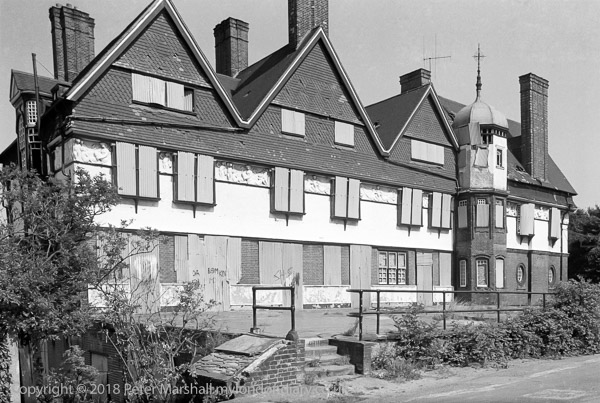London 1981
Peter MARSHALL

Gallions Hotel, Albert Basin Way, 1981
29o-33: Hotel, disused, Newham
You can click on the image to go to the next picture
Gallions Hotel was listed in 1998 and is now more or surrounded by newer buildings on three sides. It's perhaps hard to justify its II* listing; the text states it was built in '1881-83 by George Vigers and T R Wagstaffe in the manner of Norman Shaw' and has a 'Roughcast first floor with plaster frieze by Edward Roscoe', busty nymphs which earned it's nickname 'the captain's brothel'. Though it could well also have been for more literal reasons.
It was built for the Peninsular and Oriental Steam Navigation Company to house passengers leaving and arriving from steamers in Albert Dock which served ports around the British Empire and until 1940 there were direct trains from London (mainly Fenchurch St) to Gallions station close to the hotel, with more frequent services on a shuttle to Custom House station. Business slumped as the docks traffic declined and the hotel had been unused and vacant for around 9 years since 1972 when I took this picture.
The LDDC (London Docklands Development Corporation) acquired the building from the PLA in 1988 and in 1994 announced plans for a £500,000 restoration to its former glory. But it took some years and considerable development in the area around for it to become viable to reopen. The University of East London's Docklands Campus opened in 1999 and the Gallions offers a student discount.
It is now a 'gastro-pub' called the Galyons, taking its name from the 14th century family who lived in the area and gave their name to Gallions Reach where Albert Dock entrance is. The worst ever disaster on Britain's inland waterways took place on this reach in 1878 when the paddle steamer Princess Alice coming from Sheerness back to London took the wrong line and collided with the collier Bywell Castle, sinking with the loss of around 650 lives despite desperate rescue attempts. Some 130 people were saved, but sixteen of them died in the following days as the collision took place just after 75 million gallons of London's raw sewage had been released into the water there as always on the outgoing tide. Because of the extreme pollution, many of the corpses recovered from the river were in such a terrible state that they could not be identified and were buried in a mass grave in Woolwich.
It was the public outcry over the terrible effects of the pollution on the victims that finally led to the setting up of purification works at Crossness and Beckton. Raw sewage was then only released during heavy storms which overcame the capacity of the sewers. The Thames Tideway tunnel due for completion in 2023 aims to reduce the average annual discharge of 39 million tonnes of storm sewage into the Thames to meet EU allowed levels.
It was built for the Peninsular and Oriental Steam Navigation Company to house passengers leaving and arriving from steamers in Albert Dock which served ports around the British Empire and until 1940 there were direct trains from London (mainly Fenchurch St) to Gallions station close to the hotel, with more frequent services on a shuttle to Custom House station. Business slumped as the docks traffic declined and the hotel had been unused and vacant for around 9 years since 1972 when I took this picture.
The LDDC (London Docklands Development Corporation) acquired the building from the PLA in 1988 and in 1994 announced plans for a £500,000 restoration to its former glory. But it took some years and considerable development in the area around for it to become viable to reopen. The University of East London's Docklands Campus opened in 1999 and the Gallions offers a student discount.
It is now a 'gastro-pub' called the Galyons, taking its name from the 14th century family who lived in the area and gave their name to Gallions Reach where Albert Dock entrance is. The worst ever disaster on Britain's inland waterways took place on this reach in 1878 when the paddle steamer Princess Alice coming from Sheerness back to London took the wrong line and collided with the collier Bywell Castle, sinking with the loss of around 650 lives despite desperate rescue attempts. Some 130 people were saved, but sixteen of them died in the following days as the collision took place just after 75 million gallons of London's raw sewage had been released into the water there as always on the outgoing tide. Because of the extreme pollution, many of the corpses recovered from the river were in such a terrible state that they could not be identified and were buried in a mass grave in Woolwich.
It was the public outcry over the terrible effects of the pollution on the victims that finally led to the setting up of purification works at Crossness and Beckton. Raw sewage was then only released during heavy storms which overcame the capacity of the sewers. The Thames Tideway tunnel due for completion in 2023 aims to reduce the average annual discharge of 39 million tonnes of storm sewage into the Thames to meet EU allowed levels.